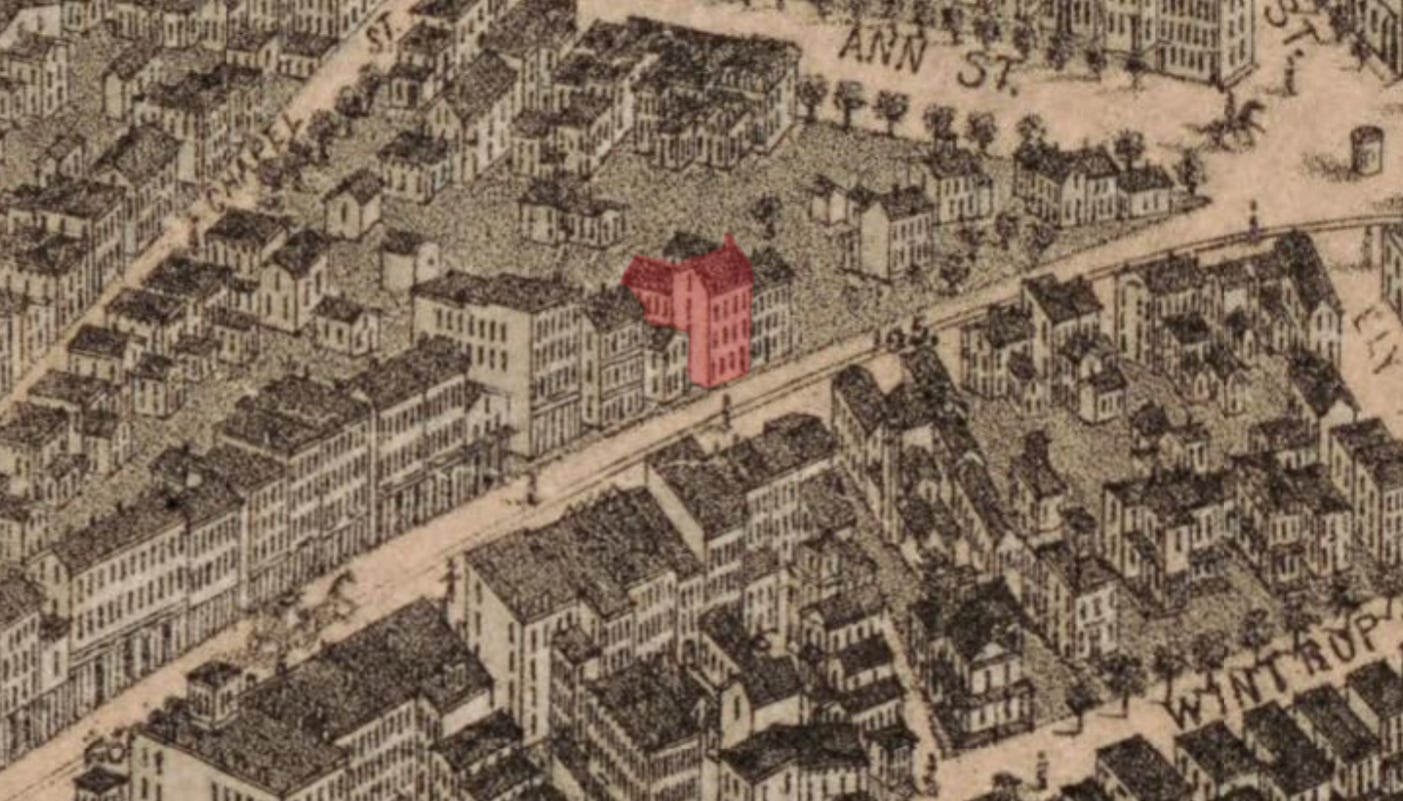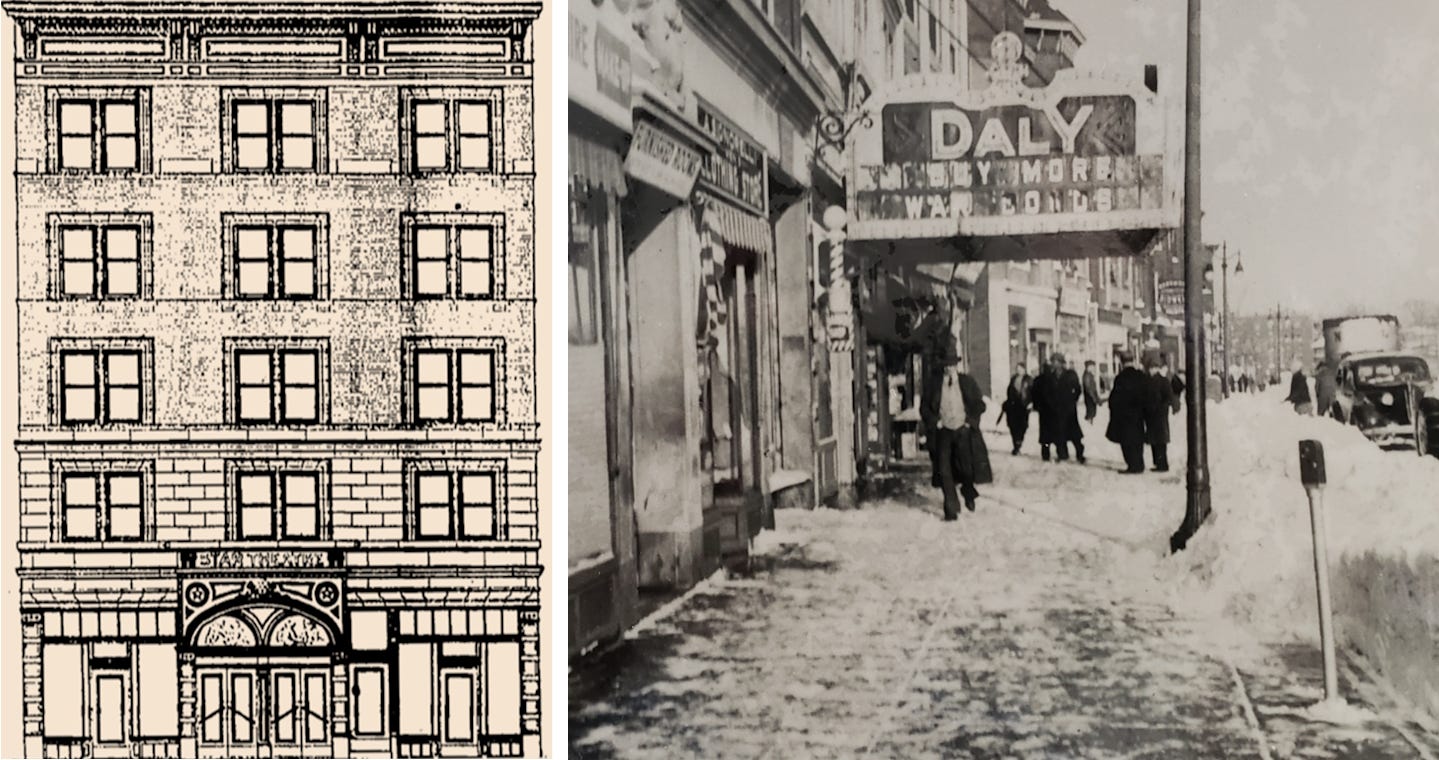Hartford’s Lost Daly Theater
Which replaced an historic house where one of the city’s oldest residents once lived
Once upon a time (as I’ve described in many videos on my YouTube channel), downtown Hartford was home to numerous movie theaters. One of these was the Star, which opened on Monday, September 29, 1913. The theater had many names over the decades, but it’s best remembered today as the Daly, which by the late 1960s had become the city’s first Spanish-language movie theater. Some of those who attended the Star’s opening night in 1913 may have recalled that the theater, located at 1255 Main Street, had previously been the site of a old house. For three quarters of a century that venerable residence had been the home of one of the city’s longest-lived residents, Miss Mary Ann Smith. They may also have known that Smith’s father had started one of Hartford’s longest-running businesses, a saddle-making company that is still in operation today.
So Where Was the Star/Daly Theater Located?
Imagine after a Yard Goat’s game you head outside and make your way to the far western corner of Dunkin’ Park. This is the point, due west of the pitcher’s mound, where Main Street intersects Pleasant Street. If you face southwest, with Dunkin’ Park on your left and Capitol Preparatory Magnet School on your right, Pleasant Street continues a short distance beyond Main, passing between parking lots until it ends at Chapel Street. This westward extension of Pleasant Street didn’t exist before 1987. Twenty years before that, there was still a long row of buildings here along the west side of Main Street that stretched from Trumbull Street all the way up to Ann Street. It was in this row, where Pleasant Street now cuts through, that the Star/Daly Theater stood for over half a century.
The Star–Empress–Art–Star–Liberty–Daly–Star–Daly Theater
As the Hartford Courant noted on September 25, 1913, the Star Theater was the largest moving picture house that had opened in the city up to that time. Patrons who attended opening night were entertained with a program of five photoplays, singing by the contralto Florence M. Sturtevant and impersonations by Nina Stella Fales. The evening’s proceeds were benefitting good causes: the Newington Home for Crippled Children and St. Vincent’s Day Nursery. The theater had an attractive ground floor façade of hand-carved Kentucky limestone. Above the entrance, the building had four more stories containing bachelor apartments.
Fourteen years later, passers-by would have noticed that the theater had a brand-new marquee above the front entrance. At 18 by 18 feet, it was much larger than its 13 by 10-foot predecessor and was also much brighter. In fact, the new marquee used more electric current than the entire interior of the theater! It’s innumerable bulbs, visible for a considerable distance along Main Street and Albany Avenue, spelled out the venue’s current name, “Liberty.” The new marquee’s debut, on March 11, 1927, marked Anthony DiLorenzo’s eighth anniversary as the theater’s owner. DiLorenzo leased the theater to Michael J. Daly, who would manage it for many years and would eventually purchase the building. This period of continuity in its operations contrasted sharply with the tumultuous first six years of the theater’s existence, a time of rapid turnover in its management and a flurry of name changes.
In October of 1914, a little over a year after it had first opened, the theater attracted considerable press attention when it was leased by Rev. Harry E. Robbins, the controversial rector of St. James Episcopal Church in West Hartford. As the Hartford Courant described it on October 10, 1914, Rev. Robbins was partly motivated by a desire for social reform. He sought to provide “an absolutely clean place where the highest class of recreation could be indulged in at a price which everyone could pay, and in a safe place.” His other objective in taking on such an unusual side-hustle for a clergyman was to supplement the $840 salary he received from the parish. As it turned out, Robbins quickly ran out of money. As the Hartford Courant described it on November 27, 1914, his inexperience in the business of theater management attracted unscrupulous traveling film agents, who “by skillful bluffing had made the rector-manager pay double and quadruple what the attractions could be booked for by an experienced man.”
Rev. Robbins’ progressive policies had already alienated prominent members of the parish, resulting in an open conflict that had been the talk of the town earlier in the year. When the rector leased the Star Theater, his enemies saw an opportunity to pounce. They claimed he had not informed the parish leadership of his plans and that he’d falsely implied in the press he had their approval to enter “the moving picture business.” By the end of November, Rev. Robbins had resigned from both the management of the Star and the rectorship of St. James’ Parish.
With the departure of Robbins, new management quickly renamed the theater The Empress. Less than a year after that, it was again renamed, this time as the Art Theater. By 1918, it had returned to the name Star Theater, but before the year was out it became the Liberty Theater. Thus began the lengthy period when the theater was managed (and later owned) by Michael J. Daly. He renamed the theater “The Daly” in the mid-1930s. In 1948, the Hartford Courant noted that Daly, who had managed a number of theaters over the years, including the Crown on Main Street and the Rialto Theater in New Britain, was the oldest independent theater operator in Hartford at the time. In that year, Daly leased the theater to a new management company, which again reverted to the name Star. By the 1960s it was the Daly again. The theater closed sometime after 1971.

The House That Came Before the Theater
So what stood at 1255 Main Street before the theater? It was the house of Normand Smith, who in 1794 started a saddle and harness-making company in Hartford that is still in business today (currently located on Homestead Avenue). The firm name went through several changes in the early years, as various partners joined and left. In 1858 it became Smith, Bourn & Company and in 1905, Smith, Worthington & Company. Smith married three times and had fifteen children. One of his sons, Charles Boardman Smith, who later became senior partner in the saddlery company, resided in a house built in 1875 that still stands today on Forest Street, across from the Harriet Beecher Stowe House and not far from the Mark Twain House. Charles’ sister, Mary Ann Smith, lived in the house her father had built in 1837 on Main Street. She would remain there until her death in 1912 at the age of 96. It was in the following year that the house was replaced by the Star Theater.
Mary Ann was born in 1816 and spent her earliest years in the family’s old homestead on Trumbull Street. That early residence stood where the George Keller-designed Hartford County Building was erected in 1882-1884. This is part of the area where the Hartford Civic Center was built in the 1970s. It was a short walk across the street from the Smith’s Trumbull Street home to the Hartford Female Seminary on Pratt Street. This institution, which Mary Ann briefly attended, was founded by Catherine Beecher, the older sister of Harriet Beecher Stowe. Later in life, Smith developed a friendship with another Hartford literary figure, Lydia Sigourney, the poet known as the “Sweet Singer of Hartford.” The two carried on a correspondence and Sigourney penned an elegy for Smith’s father Normand when he died in 1860.
According to Mary Ann Smith’s obituary in the Hartford Courant, when she was 17 years old a “disease of the right arm made her a semi-invalid and much circumscribed her activities.” A few years later, the family moved to the house on Main Street, where she would reside for the rest of her life. In her obituary in 1912, the Courant noted:
In her late years Miss Smith had lived quietly. When she became too feeble to walk in her garden and to visit her favorite spots there, “Apple Tree Lodge” and “Tranquility Cottage” she remained indoors, seated in her rooms with their quaint, old-fashioned furnishings. Mrs. Ellen F. Meafoy, who has been her constant companion for the past twenty-one years, cared for her and ordered the little household.
I don’t know what the deeply religious Smith would have thought about her home being replaced by a movie theater that would, for a very brief period, be run by a man of the cloth. I also don’t know if she had any interest in baseball. She had already resided on Main Street for nearly four decades when the Hartford Dark Blues, the city’s original baseball team, played two seasons (1874-1876) at the Hartford Ball Club Grounds in Coltsville. A little over a century after her death, Dunkin’ Park opened just yards from where she once lived.






Normand Smith was my 3x great grandfather, via his son Charles Boardman Smith. I've often wondered where exactly he lived in Hartford - thank you so very much for sharing the answer - and telling us about his daughter Mary Ann.